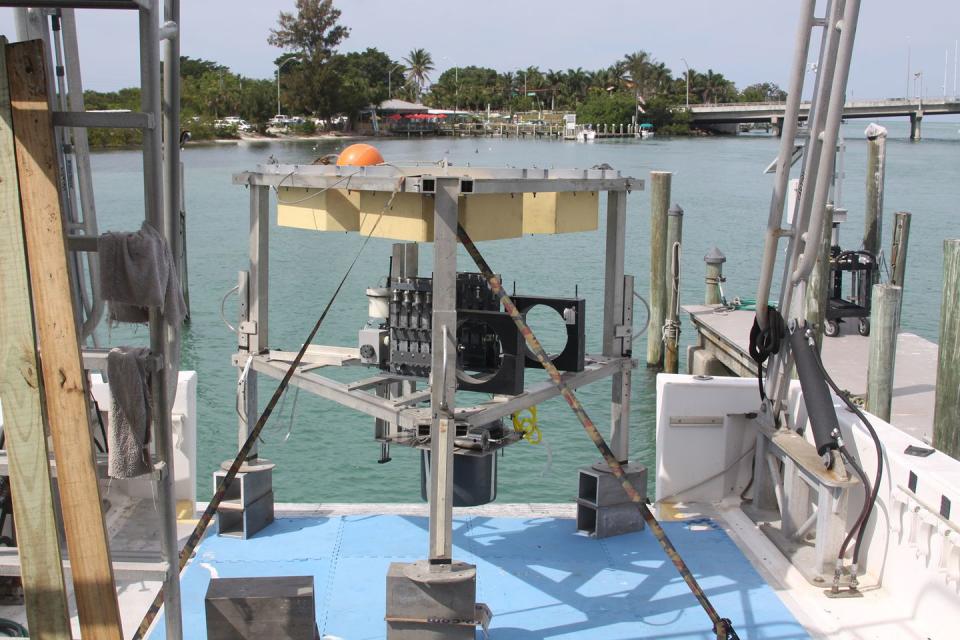Divers Are Venturing Deep Inside a Baffling Blue Hole
Researchers will aim for the 400-foot-deep bottom of an ocean sinkhole named Green Banana.
Blue holes are massive undersea sinkholes that are logistically hard to study.
The same team explored Amberjack in 2019 and is continuing its work into 2020.
Scientists are trying to explore underwater sinkholes called “blue holes,” sending divers and equipment into a well-known, mysterious spot off the coast of Florida called Green Banana.
The sinkhole begins about 150 feet down and extends to more than 400 feet deep. What do these undersea sinkholes mean, and how are they related to the rest of the ocean? There’s only one way to find out, and these researchers are diving in head first. (Technically, they’re entering feet first in accordance with best SCUBA practice.)
🕳 Let's go deeper. Explore the strangest corners of the world, solve life's most mind-bending mysteries, and get unlimited access to all things Pop Mech—starting now.
These researchers are in the middle of a 3-year project, and they explored nearby Amberjack Hole in 2019. That blue hole is 350 feet deep, making it a great stepping stone before the team attempts the even deeper Green Banana. The team includes scientists from the U.S. Geological Society, Florida Atlantic University, Mote Marine Laboratory, and Georgia Institute of Technology. They’re working with financial support from the National Oceanic and Atmospheric Administration (NOAA).
In a statement, the NOAA explains why blue holes are both perplexing and important:
“Little is known about blue holes due to their lack of accessibility and unknown distribution and abundance. The opening of a blue hole can be several hundred feet underwater, and for many holes, the opening is too small for an automated submersible. In fact, the first reports of blue holes did not come from scientists or researchers, but actually came from fishermen and recreational divers.”
For this project, researchers built an item they call a “benthic lander”—the benthic zone is the seafloor, in this case, or the “floor” portion of any body of water. The lander is shaped like a triangular prism, and a cage of metal tubing encloses a platform where scientific instruments are mounted. Having three landing points makes it stable on more kinds of terrain than, say, a four-legged or flat-bottomed form factor. The lander weighs 600 pounds and is carefully lowered from the surface.

For the human researchers, making the dive into Amberjack and now Green Banana is also a very big deal. Amberjack’s opening is at 113 feet and Green Banana’s is at 155 feet. The typical SCUBA certification gets divers comfortable to about 40 feet, past which they must use specialized learning—it’s safe and doable, but extensive planning and the potential for danger rules out most vacation divers.
PADI’s Deep Diver course trains divers for up to 130 feet. That only gets a diver to the mouth of Amberjack and within spitting distance of the entryway to Green Banana. The researchers taking the plunge into Green Banana are well trained, decked out in safety gear, and still very courageous. And once they’re in the column of water inside Green Banana, they can take samples and run all kinds of tests, using the equipment and tools on the benthic lander for support.
From the NOAA statement:
“Water samples collected by divers and the lander yielded microbes whose DNA was extracted, processed to isolate specific marker genes, and analyzed. Scientists found that the microbes in the hole are layered, with different genetic varieties at different relative abundances among the top, middle and bottom layers of water.”
In Amberjack, the scientists found two intact specimens of an endangered sawfish species.
As if planning an expedition in August 2020 wasn’t hard enough, Green Banana isn’t just 20 percent deeper. “The configuration of the hole is somewhat hourglass shaped, creating new challenges for the lander deployment and water sampling,” NOAA explains.
Having a crimp in the middle means Green Banana likely has a different array of genetic specimens at the same relative levels as Amberjack, because the geometry has likely affected how the organisms live and spread out in the space.
You Might Also Like

